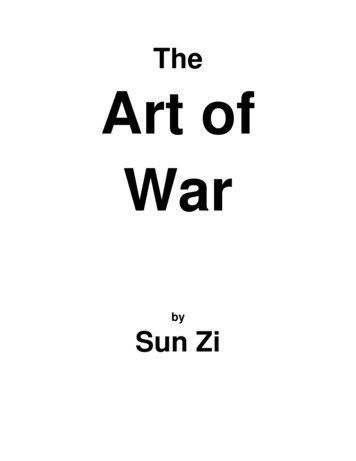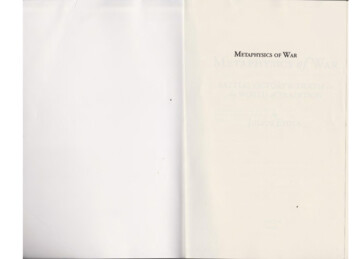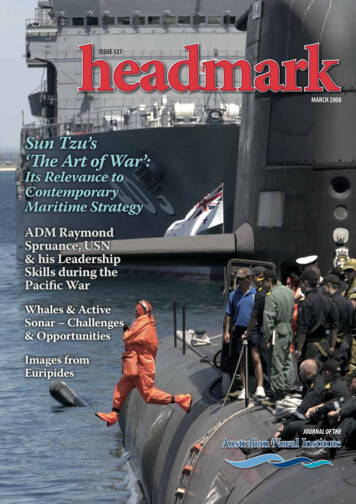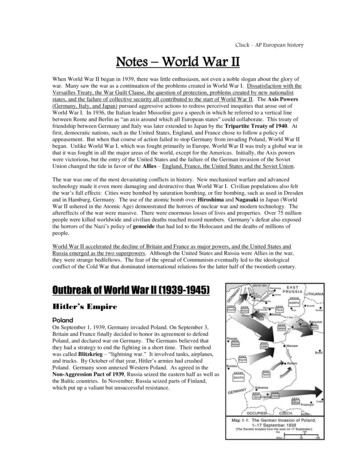
Transcription
TheArt ofWarbySun Zi
Table of Contents1.Planning . 12.Waging War . 83.Attacking Strategically .144.Making Tactical Arrangements .215.Allocating Energy .266.Using Weaknesses and Strengths .337.Maneuvering .428.Varying Tactics .509.Preparing the Army.5510. Evaluating Terrains.6711. Evaluating Battlegrounds .7612. Attacking with Fire .9313. Using Intelligence .98Appendix .105Origin of Sun Zi's Art of War.105List of Tables .107References .126Index .127Acknowledgements .236
The Art of War, 1. Planning1.OverviewPlanningThere are Five Factors governing the art of war.There are Seven Considerations to forecast victory or defeat.In addition to profiting from my suggestions, use any helpful circumstancesbeyond the ordinary rules.Warfare is based on deception.Attack the enemy when they are unprepared; emerge where you are notexpected.You are more likely to win if you plan.1
The Art of War, 1. Planning1.5 FactorsSun Zi said: The art of war is of vital importance to the State;it is a matter of life and death; it is a road to safety or ruin.Hence it must be investigated.2.The art of war, then, is governed by Five Factors; these areto be taken into account in one’s deliberations, whenseeking to determine the conditions existing in the field:Moral Influence, Nature, Terrain, Leadership, and Method.—2.1.Moral Influence causes the people to be in completeaccord with their ruler; thus, the people will be preparedto live and die, unafraid of danger.2.2.Nature signifies entities that operate without purpose, likenight and day, cold and heat, times and seasons.2.3.Terrain comprises—2.3.1.Distances, great and small;2.3.2.Danger and security;2.3.3.Accessible and Constricted battlegrounds; and2.3.4.Chances of life and death.2
The Art of War, 1. Planning2.4.5 FactorsLeadership represents the virtues e,2.4.4.Courage, and2.4.5.Discipline.2.5.Method can be understood by—2.5.1.Organizational control,2.5.2.Leadership resources may reach the army, and2.5.4.3.Controlled use of resources.The Five Factors governing the art of war ([2.1, 2.5]) shouldbe familiar to all generals; they who know them will bevictorious; they who do not know them will be defeated.3
The Art of War, 1. Planning4.7 ConsiderationsTherefore, in your deliberations, evaluate the SevenConsiderations to determine the military conditions.—4.1.Does your ruler have Moral Influence?4.2.Does your general have ability?4.3.Are advantages of Nature and Terrain harmonized?4.4.Is discipline rigorously enforced?4.5.Is your army strong?4.6.Are officers and troops highly trained?4.7.Are rewards and punishments consistent?5.By means of these Seven Considerations I can forecastvictory or defeat.4
The Art of War, 1. Planning6.Helpful CircumstancesThe general who listens to my suggestions and acts onthem, will be victorious; keep such a general in control. Thegeneral who does not listen to my suggestions nor acts onthem, will be defeated; dismiss such a general.7.In addition to profiting from my suggestions, use any helpfulcircumstances beyond the ordinary rules.8.In accordance with favorable circumstances, one shouldmodify one’s plans.9.9.1.Warfare is based on deception.—The following strategies depend on your condition (TableA1):9.1.1.If you are capable, seem incapable;9.1.2.If you are able to advance, seem unable to do so;9.1.3.If you are near your goal, seem far from your goal; and9.1.4.If you are far from your goal, seem near your goal.5
The Art of War, 1. Planning10.Helpful CircumstancesThe following strategies depend on disadvantages of theenemy (Table A2):10.1.If the enemy is greedy, hold out baits to entice them;10.2.If the enemy is disordered, capture them;10.3.If the enemy is irritable, irritate them; and10.4.If the enemy is underestimating you, encouragetheirarrogance.11.The following strategies depend on advantages of theenemy (Table A3):11.1.If the enemy is poised, be prepared for them;11.2.If the enemy is strong, avoid them;11.3.If the enemy is relaxed, tire them; and11.4.If the enemy is united, separate them.12.Attack the enemy when they are unprepared; emerge whereyou are not expected.13.These military strategies ([7, 12]), leading to victory, cannotbe decided nor divulged prematurely.6
The Art of War, 1. Planning14.Make Thorough PlansNow the generals who win battles make thorough plans intheir sanctuaries before the battles begin. The generals wholose battles make but partial plans. Thus do thorough planslead to victory, and partial plans to defeat; you are morelikely to be defeated if you do not plan! It is by attention tothis point that I can foresee who is likely to win or lose.7
The Art of War, 2. Waging War2.OverviewWaging WarThe cost of developing an army of many people will reach a significant totaleach day.Be thoroughly acquainted with the dangers of wars, so you can thoroughlyunderstand the profitable ways of waging them.Get food from the enemy.Use the enemy to augment your strength.Let your great object be victory, not lengthy operations.8
The Art of War, 2. Waging War1.Army CostsSun Zi said: In the operations of war, to develop an army ofmany people, the following are general rules:1.1.We will need many—1.1.1.Chariots,1.1.2.Wagons,1.1.3.Soldiers, and1.1.4.Supplies;1.2.The internal and external expenses ,1.2.3.Security,1.2.4.Maintenance, and1.2.5.Miscellaneous.2.Thus, the cost of developing an army of many people willreach a significant total each day.9
The Art of War, 2. Waging War3.Do Not DelayWhen you engage in actual fighting, if victory is long incoming, then the troops’ weapons will grow dull and theirardor will be damped. If you besiege a city, you will exhaustyour strength.4.Again, if the campaign is prolonged, the resources of theState will not be equal to the strain.5.Now, when your weapons are dulled, your ardor damped,your strength exhausted and your funds spent, neighboringwarlords will spring up to use your extremity. Then ces that must ensue.6.Thus, though we have heard that haste in war causesmistakes, cleverness has never been associated with longdelays.7.There is no instance of a nation having benefited fromprolonged warfare.10
The Art of War, 2. Waging War8.Dangers of WarIt is only one who is thoroughly acquainted with the dangersof wars who can thoroughly understand the profitable waysof waging them.9.Skillful warriors do not conscript a soldier a second time, norare their supplies refilled.10.Bring your military equipment from home, and get food fromthe enemy. Thus the army will have food enough for itsneeds.11.Poverty of the State may occur if all its supplies aretransported long distances. Transporting supplies to an verished and unmotivated.12.The proximity of an army causes prices to go up, and highprices cause contributors’ wealth to be drained away.13.When contributors’ wealth is drained away, they will beafflicted by heavy exactions.14.With this loss of wealth and exhaustion of strength, thehomes of the people will be emptied of supplies, and asignificant fraction of their income will be dissipated.11
The Art of War, 2. Waging War15.Get Food from the EnemyA significant portion of the army’s total resources will amountfrom the following pears,15.5.Bows and arrows,15.6.Shields, and15.7.Heavy wagons.16.Hence, a wise general makes a point of commandeeringfood from the enemy. One cartload of food from the enemyis equivalent to twenty of one's own; likewise, one picul oftheir fodder is equivalent to twenty from one's own supply.12
The Art of War, 2. Waging War17.Enemies Augment StrengthFor the army to win, the troops must be inspired; that theremay be advantage from the army winning, they must havetheir rewards.18.Therefore, when a person captures a chariot—18.1.Reward the person who captured the chariot,18.2.Your army’s banner should be substituted for that of theenemy,18.3.Chariots captured from the enemy should be used inconjunction with those of your army, and18.4.Soldiers captured from the enemy should be kindlytreated and kept.19.This is called using the enemy to augment one's ownstrength.20.In war, then, let your great object be victory, not lengthyoperations.21.Thus it may be known that the general of armies is thearbiter of the people’s fates, and the person on whom itdepends whether the army shall be in peace or in peril.13
The Art of War, 3. Attacking Strategically3.OverviewAttacking StrategicallyThe best strategy of all is to remain intact rather than allowing damage.Use strategies dependent on the ratio of the number of troops of your armyto that of the enemy to prevent your army from being overtaken by a largerone.Generals can bring misfortune on their armies by hobbling them, causingrestlessness in their officers’ and troops’ minds, and shaking their officers’and troops’ confidence.Victory lies in the knowledge of the Five Predictors of Victory.If you know the enemy and know yourself, you need not fear the result of ahundred battles.14
The Art of War, 3. Attacking Strategically1.Best StrategySun Zi said: In the practical art of war, the best strategy of allis to remain intact rather than allowing damage. This ns,1.4.Companies, and1.5.Squadrons.2.Hence, to fight and win in all your battles is not SupremeExcellence; Supreme Excellence consists of achievingvictory without battling.15
The Art of War, 3. Attacking Strategically3.Forms of GeneralshipThus, the following are the forms of generalship:3.1.Best is to affect the enemy’s plans,3.2.Second best is to prevent enemy alliances,3.3.Third is to attack the enemy’s army, and3.4.Worst is to besiege a fortified city.—3.4.1.The rule is not to besiege a fortified city, if it can beavoided.3.4.2.Preparing to besiege fortified cities will take muchtime, and building ramps will take much more time.3.4.3.If generals, unable to control their irritations, launchtheir troops to the assault like swarming ants, many oftheir troops will be exhausted, and the city will not beconquered. Such are the disastrous effects ofbesieging a fortified city.16
The Art of War, 3. Attacking Strategically4.Strategic AttacksTherefore, skillful generals—4.1.Subdue the enemy, without any battling;4.2.Conquer cities, without besieging them;4.3.Capture enemy soldiers, without lengthy campaigns; and4.4.Contend for supremacy, with their armies intact.5.Thus, without losing troops, skillful generals’ victories will becomplete. This is the art of strategic attacks.17
The Art of War, 3. Attacking Strategically6.Ratio of TroopsThe following strategies depend on the ratio of the numberof troops of your army to that of the enemy (Table A4):6.1.If your army is ten to the enemy’s one, surround them;6.2.If your army is five to the enemy’s one, attack them;6.3.If your army is two to the enemy’s one, separate them;6.4.If your army is equally balanced, you can engage theenemy;6.5.If your army is slightly inferior in numbers, you can avoidthe enemy; and6.6.If your army is quite unequal to the enemy in every way,you can flee from the enemy.7.Hence, though an obstinate effort may be made by a smallarmy, in the end it will be overtaken by the larger army.18
The Art of War, 3. Attacking Strategically8.Misfortune Generals Can BringNow the general is the support of the army; if the support iscomplete at all points, the army will be strong; if the supportis defective, the army will be weak.9.9.1.Generals can bring misfortune on their armies by—Instructing the army to advance or retreat, being ignorantof the fact that it cannot obey—hobbling the army;9.2.Attempting to govern armies in the same way as theyadminister territories, being ignorant of the conditions thatexist in an army—causing restlessness in the officers’and troops’ minds; and9.3.Hiring the officers of their armies without discrimination,through ignorance of the military principle of adaptation �confidence.10.When the people in the army are restless and distrustful,trouble is sure to come from the enemy. This is simplybringing anarchy into the army, and flinging victory away.19
The Art of War, 3. Attacking Strategically11.5 Predictors of VictoryThus, we may know there are Five Predictors of Victory:11.1.Knowing when to fight and when not to fight;11.2.Knowing how to handle both large and small forces;11.3.Animating armies by the same spirit throughout all theirranks;11.4.Prepared themselves, waiting to conquer unpreparedenemies; and11.5.12.Being capable and not interfered with by rulers.Victory lies in the knowledge of the Five Predictors ofVictory.13.13.1.Hence the saying—“If you know the enemy and know yourself, you need notfear the result of a hundred battles;13.2.“If you know yourself but not the enemy, for every victorywon you will also suffer a defeat;13.3.“If you know neither the enemy nor yourself, you will bedefeated in every battle.”20
The Art of War, 4. Making Tactical Arrangements4.OverviewMaking Tactical ArrangementsOne may know how to win without being able to do it.Victories of clever warriors bring them neither reputation for wisdom norcredit for courage, because they excel in winning with ease.In respect of Method, we have Measurement, Estimation of Quantity,Calculation, Balancing of Chances, and Victory.21
The Art of War, 4. Making Tactical Arrangements1.Security Against DefeatSun Zi said: The good warriors of old first put themselvesbeyond the possibility of defeat, and then waited for anopportunity of defeating the enemy.2.To secure ourselves against defeat lies in our own hands,but the opportunity to defeat the enemy is provided by theenemy themselves.3.Thus, good warriors are able to secure themselves againstdefeat, but cannot make certain of defeating the enemy.4.Hence the saying, “One may know how to win without beingable to do it.”22
The Art of War, 4. Making Tactical Arrangements5.Excel in Winning with EaseSecurity against defeat requires defensive tactics; ability todefeat the enemy requires offensive tactics.6.Standing on the defensive indicates insufficient strength;advancing, a superabundance of strength.7.The generals who are skilled in defense hide in the mostsecret recesses of the earth; they who are skilled in offenseuse the least predictable tactics. Thus, not only can theyprotect themselves, but they can also achieve completevictory.8.To predict victory that an average person could predict is notthe acme of excellence.9.Neither is it the acme of excellence if, after you fight andwin, everyone says, “Well done!”10.To lift a thin hair is no sign of great strength; to see the sunand moon is no sign of keen sight; to hear the noise ofthunder is no sign of keen hearing.11.What the wise call a clever warrior is one who not only wins,but excels in winning with ease.12.Hence, the victories of clever warriors bring them neitherreputation for wisdom nor credit for courage.23
The Art of War, 4. Making Tactical Arrangements13.Excel in Winning with EaseClever warriors make no mistakes, because they usestrategies that maximize the likelihood of success; theydefeat their enemies, because they only fight enemies theyknow they can defeat.14.Hence, skillful warriors put themselves into positions thatmake defeat impossible, and do not miss the opportunitiesfor defeating the enemy.15.Thus it is that in war the successful strategists only attackafter the methods of victory have been determined, whereasthey who are destined to defeat first attack and afterwardsdetermine the methods of victory.24
The Art of War, 4. Making Tactical Arrangements16.Control VictoryConsummate generals cultivate Moral Influence, and strictlyadhere to Method; thus, it is in their power to control victory.17.In respect of Method, we have—17.1.Firstly, Measurement;17.2.Secondly, Estimation of Quantity;17.3.Thirdly, Calculation;17.4.Fourthly, Balancing of Chances; and17.5.Fifthly, Victory.18.Terrain leads to Measurement; Measurement to tion;Calculation to Balancing of Chances; and Balancing ofChances to Victory.19.A victorious army opposed to a defeated one, is a preparedarmy matched against an unprepared one.20.The onrush of an advancing army is like the bursting of pentup waters into a deep chasm.25
The Art of War, 5. Allocating Energy5.OverviewAllocating EnergyControl a large army by dividing its numbers, and operate a large army byinstituting signs and ctmethodsareinexhaustible.Good warriors will be ardent in their attacks, and precise in their timing andaccuracy.The enemy acts according to appearances of skillful warriors.The energy developed by good troops is as the momentum of round stonesrolled down high mountains.26
The Art of War, 5. Allocating Energy1.Control of a Large ArmySun Zi said: The control of a large army is fundamentally thesame as the control of a few people; it is merely a questionof dividing their numbers.2.Operating with a large army under your instruction is nodifferent from operating with a small one; it is merely aquestion of instituting banners and flags.27
The Art of War, 5. Allocating Energy3.Direct and Indirect MethodsTo ensure that your whole army may withstand the brunt rs direct and indirect.4.That the impact of your army may be like a stone smashedagainst an egg: This is affected by the science ofweaknesses and strengths.5.In all battles, direct methods may be used for engaging theenemy, but indirect methods will be needed to securevictory.6.Indirect tactics, efficiently applied, are inexhaustible asNature and Terrain, unending as the flow of rivers andstreams; like the sun and moon, they end but to begin anew;like the four seasons, they pass away to return once more.7.There are not more than twelve musical notes, yet thecombinations of these twelve give rise to more melodiesthan can ever be heard.8.There are not more than three primary colors (yellow, red,and blue), yet in combinations they produce more hues thancan ever be seen.9.There are not more than five cardinal tastes (sour, acrid,salt, sweet, bitter), yet combinations of them yield moreflavors than can ever be tasted.28
The Art of War, 5. Allocating Energy10.Direct and Indirect MethodsIn war, there are not more than two methods of operation—the direct and the indirect—yet these two in combinationsgive rise to an endless series of maneuvers.11.The direct and indirect lead on to each other in turn. It is likemoving in a circle, because you never come to an end. Whocan exhaust the possibilities of their combinations?29
The Art of War, 5. Allocating Energy12.Be Ardent and PreciseThe unleashing of accumulated energy enables the onrushof a gushing torrent to roll stones along its course.13.The control of timing and accuracy enables the swoop of abird of prey to destroy its target.14.Therefore, good warriors will be ardent in their attacks, andprecise in their timing and accuracy.15.Their potential energy is like that of a loaded weapon; theirtiming and accuracy, like that of the release of the trigger.16.Amid the turmoil and tumult of war, there may be externaldisorder, but no internal disorder may occur; amid confusionand chaos, the general must maintain control of the soldiersto avert defeat.30
The Art of War, 5. Allocating Energy17.Simulated AppearancesThey who are skillful at controlling activity maintainsimulated appearances (Table A5).—17.1.17.1.1.If you are superbly organized, simulate disorder.—Hiding order beneath the cloak of disorder is simply aquestion of subdivision.17.2.17.2.1.If you are courageous, simulate pposes a fund of potential energy.17.3.17.3.1.If you are strong, simulate weakness.—Masking strength with weakness is affected by tacticalarrangements.18.Thus, the enemy acts according to appearances of skillfulwarriors.19.Entice the enemy by offering benefits they certainly want.20.After moving the enemy with benefits, capture the enemywith groups of picked troops.31
The Art of War, 5. Allocating Energy21.Clever warriors—21.1.Look to the effect of combined energy and21.2.Do not require too much from individuals.22.Hence, they can—22.1.Choose the right people and22.2.Use combined energy.23.Combined EnergyWhen clever warriors use combined energy, their troopsbecome like rolling logs or stones.—23.1.They remain quiet when established, as logs and stonesremain motionless on level ground.23.2.They move when in unstable positions, as logs andstones move on slopes.23.3.They deliberate when challenged, as logs and stonescome to standstills when four-cornered.23.4.They gain momentum with progress, as logs and stonescontinue to roll when round-shaped.24.Thus, the energy developed by good troops is as themomentum of round stones rolled down high mountains; thisis how clever warriors use combined energy.32
The Art of War, 6. Using Weaknesses and Strengths6.OverviewUsing Weaknesses and StrengthsAttack places where the enemy must hasten to defend; advance swiftly toplaces where you are not expected.Those generals are skillful in offense whose enemies do not know what todefend; and they are skillful in defense whose enemies do not know whatto attack.Manage the enemy’s weaknesses, and move more rapidly than the enemy.If we wish to fight, the enemy can be compelled to an engagement; if we donot wish to fight, we can prevent the enemy from engaging us.If we are able to attack an inferior force, our opponents will be defeated.Numerical weakness comes from having to prepare against possibleattacks; numerical strength, from compelling the enemy to make thesepreparations against us.If we know the place and time of battles, we can plan adequately and beready to fight.All people can see the tactics whereby I win, but what none can see is thestrategy out of which victory is evolved.Change is a constant factor.33
The Art of War, 6. Using Weaknesses and Strengths1.Places to AttackSun Zi said: Whoever is first in the battlefield, and awaits thecoming of the enemy, will be fresh for battle; whoever issecond in the battlefield, and must hasten to battle, willarrive exhausted.2.2.1.Therefore, clever warriors (Table A6)—Overwhelm the enemy, instead of being overwhelmed bythem;2.2.Cause the enemy to approach of their own accord, byholding out advantages to them; and2.3.Make it impossible for the enemy to come, by providingincentives for them to stay.3.The following strategies depend on the enemy’s conditions(Table A7):3.1.If the enemy is relaxing, tire them;3.2.If the enemy is well-supplied with food, starve them out;and3.3.If the enemy is comfortably encamped, force them tomove.4.Attack places where the enemy must hasten to defend;advance swiftly to places where you are not expected.34
The Art of War, 6. Using Weaknesses and Strengths5.Offense and DefenseAn army may make great progress without distress, if itadvances through territory where there is no enemy.—5.1.To be sure of succeeding in your attacks, only attackenemies that are unprepared.5.2.To ensure the safety of your defense, only hold positionsthat cannot be attacked.6.Hence, those generals are skillful in offense whose enemiesdo not know what to defend; and they are skillful in defensewhose enemies do not know what to attack.7.Through the principles of subtlety and secrecy, we learn tobe invisible and inaudible; hence, we can control our fates.8.You may advance and encounter no resistance, if youmanage the enemy’s weaknesses;9.You may retire and be safe from pursuit, if your movementsare more rapid than those of the enemy.35
The Art of War, 6. Using Weaknesses and Strengths10.Defeat OpponentsIf we wish to fight, the enemy can be compelled to anengagement even though they are sheltered behind highbarriers and deep refuges. All we need to do is attack someother place that they will be obliged to rescue.11.If we do not wish to fight, we can prevent the enemy fromengaging us even though the lines of our encampment aremerely traced out. All we need to do is throw something oddand unaccountable in their way.12.By discovering the enemy’s arrangements and remaininghidden ourselves, we can keep our army concentrated, whilegroups of the enemy are divided.13.We can form a single, united body, while groups of theenemy are split into fractions. Hence, there will be a wholeagainst separate parts of a whole, which means we shall bemany to the enemy’s few.14.If we are able, thus, to attack an inferior force, ouropponents will be defeated.36
The Art of War, 6. Using Weaknesses and Strengths15.Numerical PowerThe spot where we intend to attack must not be madeknown so that the enemy will have to prepare againstpossible attacks at several different points; with their armydistributed in many directions, the numbers we shall have toface at any given point will be proportionately few.—15.1.If the enemy strengthens their foremost divisions, theywill weaken their rear divisions.15.2.If the enemy strengthens their rear divisions, they willweaken their foremost divisions.15.3.If the enemy strengthens their left sides, they will weakentheir right sides.15.4.If the enemy strengthens their right sides, they willweaken their left sides.15.5.If the enemy sends reinforcements everywhere, they willeverywhere be weak.16.Numerical weakness comes from having to prepare againstpossible attacks; numerical strength, from compelling theenemy to make these preparations against us.37
The Art of War, 6. Using Weaknesses and Strengths17.Plan AdequatelyIf we know the place and time of battles, we can planadequately and be ready to fight.18.If neither place nor time be known, then the left side cannotrescue the right side, the right side equally cannot rescuethe left side, the front unable to relieve the rear, or the rearto support the front. This is much more problematic if thesections of the army that have made the least progresstoward their goals are far behind, and communication isineffective.19.If the number of your troops is less than that of the enemy,that does not guarantee the enemy advantage in the matterof victory. You can create victory.38
The Art of War, 6. Using Weaknesses and Strengths20.Evolution of VictoryIf the enemy is greater in numbers, we may prevent themfrom engaging us by (Table A8)—20.1.Scheming, so as to discover the enemy’s plans and thelikelihood of their success;20.2.Rousing the enemy, and learning the principle of theiractivity or inactivity;20.3.Compelling the enemy to reveal themselves, so as tolearn their characteristics; and20.4.Carefully comparing the enemy’s army with our own, soyou may know where strength is superabundant andwhere it is deficient.21.In making tactical arrangements, the highest level you ents, you will be safe from—21.1.Prying of the subtlest spies and21.2.Plots of the wisest brains.22.This is what average people cannot comprehend: Howvictory may be produced out of the enemy’s tactics.23.All people can see the tactics whereby I win, but what nonecan see is the strategy out of which victory is evolved.39
The Art of War, 6. Using Weaknesses and Strengths24.Evolution of VictoryDo not repeat the tactics that have gained you one victory,but let your methods be regulated by the infinite variety ofcircumstances.25.Military tactics are like water, for water in its naturalcourse—25.1.Runs away from high places and25.2.Hastens downwards.26.So in war, the way is to—26.1.Avoid what is strong and26.2.Strike at what is weak.27.Soldiers achieve their victories in relation to the enemy theyare facing, as water shapes its course according to thenature of the ground over which it flows.28.As water retains no constant shape, in war there are noconstant conditions.29.They who can modify their tactics in relation to thecircumstances of the enemy and thereby succeed inwinning, may be called marvelous leaders.40
The Art of War, 6. Using Weaknesses and Strengths30.30.1.Change is a Constant FactorThus, change is a constant factor.—The elements of the universe are not always equallyprominent.30.2.The
The Art of War, 1. Planning 5 Factors 2 1. Sun Zi said: The art of war is of vital importance to the State; it is a matter of life and death; it is a road to safety or ruin. Hence it must be investigated. 2. The art of war, then, is governed by Five Factors; these are to be taken into account in one's deliberations, when










